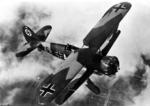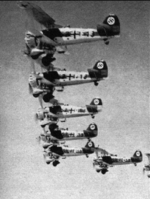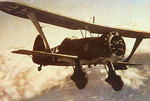Hs 123
| Country | Germany |
| Manufacturer | Henschel & Sohn |
| Primary Role | Ground Attack Aircraft |
| Maiden Flight | 8 May 1935 |
Contributor: C. Peter Chen
ww2dbaseThe Hs 123 sesquiplane-biplane dive bombers were the first aircraft built by Henschel, until this time a locomotive manufacturer. They were intended to replace the aging He 50 biplanes currently in reconnaissance and dive bombing roles, but the production, which began in 1936, was limited because the German military knew a more modern design was already in the works (which was to come in the form of the Ju 87 Stuka design by Junkers a year later), and naturally there were no significant upgrades as the planned obsolescence made upgrades unnecessary.
ww2dbaseHs 123 aircraft entered German service in the fall of 1936 and first saw combat during the Spanish Civil War, where they served poorly as dive bombers and satisfactorily as ground support aircraft. Several Hs 123 aircraft were kept by Spain for testing after the Civil War.
ww2dbaseTwelve Hs 123 aircraft were also exported to Nationalist China in 1936, before Sino-German relations worsened. They were used extensively as dive bombers against Japanese vessels in the Yangtze River, particularly in 1938.
ww2dbaseIn the European War, 39 Hs 123 aircraft saw combat during the German invasion of Poland, where they were reported as reliable and were able to take a good deal of damage from ground fire. Some of them were also engaged in the invasion of the Low Countries and France in the following year, serving in tandem with Ju 87 Stuka dive bombers by filling the ground support role. They also saw action during the Balkans Campaign. 22 of them served during Operation Barbarossa after receiving additional armor and extra machine guns, both to improve their capability as ground support aircraft; they were involved in actions at Bryansk, Moscow, Crimea, Stalingrad, and Kursk. They remained in front line service until mid-1944 before Ju 87 Stuka aircraft finally replaced them completely. They served in supply and glider towing duties until the end of the European War.
ww2dbaseProduction of the Hs 123 design lasted from 1936 until 1940. Less than 1,000 units were built. In Jan 1943, Colonel General Wolfram von Richthofen of Luftflotte 4 inquired whether Henschel could restart the production of Hs 123 biplanes due to their flexibility on the front lines, particularly with their capability to take off and land on muddy airfields, but Henschel had since dismantled the entire Hs 123 production line, making the request impossible.
ww2dbaseSource: Wikipedia.
Last Major Revision: May 2008
SPECIFICATIONS
Hs 123
| Machinery | One BMW 132Dc 9-cylinder radial engine rated at 880hp |
| Armament | 2x7.92mm Mg 17 machine guns (some field modification replaced with 2x20mm MG FF cannon), up to 450kg bombs |
| Crew | 1 |
| Span | 10.50 m |
| Length | 8.33 m |
| Height | 3.20 m |
| Wing Area | 24.85 m² |
| Weight, Empty | 1,500 kg |
| Weight, Loaded | 2,215 kg |
| Speed, Maximum | 341 km/h |
| Service Ceiling | 9,000 m |
| Range, Normal | 860 km |
Photographs
 |  |  |  |
Please consider supporting us on Patreon. Even $1 per month will go a long way! Thank you. Please help us spread the word: Stay updated with WW2DB: |
Visitor Submitted Comments
4 Nov 2021 06:24:31 AM
huh whell um did they also sink a grman ship?
All visitor submitted comments are opinions of those making the submissions and do not reflect views of WW2DB.
- » US Women's Army Corps "Six Triple Eight" Awarded with Congressional Gold Medal (30 Apr 2025)
- » Wreck of Soviet Submarine M-49 Found (10 Apr 2025)
- » Japanese Emperor Visited Iwoto (Iwo Jima) (8 Apr 2025)
- » Race, Holocaust, and African-American WW2 Histories Removed from the US Naval Academy Library (7 Apr 2025)
- » US Government Plans to Purge WW2 Information (17 Mar 2025)
- » See all news
- » 1,167 biographies
- » 337 events
- » 44,617 timeline entries
- » 1,244 ships
- » 350 aircraft models
- » 207 vehicle models
- » 376 weapon models
- » 123 historical documents
- » 261 facilities
- » 470 book reviews
- » 28,516 photos
- » 365 maps
General Douglas MacArthur at Leyte, 17 Oct 1944
Please consider supporting us on Patreon. Even $1 a month will go a long way. Thank you!
Or, please support us by purchasing some WW2DB merchandise at TeeSpring, Thank you!
12 Apr 2010 07:29:22 PM
Twelve Hs 123 aircraft were also exported to Nationalist China in 1936, before Sino-German relations worsened. They were used extensively as dive bombers against Japanese vessels in the Yangtze River, particularly in 1938.
YES!We used Hs123 to fight against the evil *** !